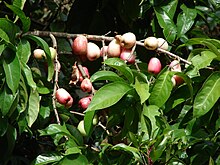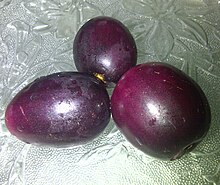bio.wikisort.org - Plant
Syzygium is a genus of flowering plants that belongs to the myrtle family, Myrtaceae. The genus comprises about 1200 species,[3][4][5] and has a native range that extends from Africa and Madagascar through southern Asia east through the Pacific.[6] Its highest levels of diversity occur from Malaysia to northeastern Australia, where many species are very poorly known and many more have not been described taxonomically.
| Syzygium | |
|---|---|
 | |
| Syzygium malaccense | |
| Scientific classification | |
| Kingdom: | Plantae |
| Clade: | Tracheophytes |
| Clade: | Angiosperms |
| Clade: | Eudicots |
| Clade: | Rosids |
| Order: | Myrtales |
| Family: | Myrtaceae |
| Subfamily: | Myrtoideae |
| Tribe: | Syzygieae |
| Genus: | Syzygium P. Browne ex Gaertn.[1] |
| Species | |
|
About 1100; see List of Syzygium species | |
| Synonyms[2] | |
|
List
| |


Most species are evergreen trees and shrubs. Several species are grown as ornamental plants for their attractive glossy foliage, and a few produce edible fruits that are eaten fresh or used in jams and jellies. The most economically important species, however, is the clove Syzygium aromaticum, of which the unopened flower buds are an important spice. Some of the edible species of Syzygium are planted throughout the tropics worldwide, and several have become invasive species in some island ecosystems. Several species of Syzygium bear fruits that are edible for humans, many of which are named "roseapple". Fifty-two species are found in Australia and are generally known as lillipillies, brush cherries or satinash.[7]
At times Syzygium was confused taxonomically with the genus Eugenia (c. 1000 species), but the latter genus has its highest specific diversity in the neotropics. Many species formerly classed as Eugenia are now included in the genus Syzygium, although the former name may persist in horticulture.[7] The Syzygium Working Group, an international group of researchers, formed in April 2016 with the aim to produce a monograph of Syzygium.[5]
Species


Selected species include:[3]
- Syzygium acre (Pancher ex Guillaumin) J.W.Dawson
- Syzygium alliiligneum – onionwood (Queensland)
- Syzygium alternifolium (Wight) Walp.
- Syzygium ampliflorum (Koord. & Valeton) Amshoff
- Syzygium amplifolium
- Syzygium andamanicum
- Syzygium anisatum
- Syzygium angophoroides
- Syzygium anisosepalum
- Syzygium antisepticum – shore eugenia
- Syzygium apodophyllum (F.Muell.) B.Hyland - endemic to Queensland, Australia
- Syzygium aqueum – water apple, bell fruit, water cherry, watery rose apple
- Syzygium aromaticum – clove
- Syzygium australe – brush cherry (Australia)
- Syzygium beddomei
- Syzygium bourdillonii
- Syzygium canicortex – yellow satinash (Queensland)
- Syzygium caryophyllatum (type species)
- Syzygium chavaran
- Syzygium claviflorum (Roxb.) Wall. ex Steud. – Australia, New Guinea, Southeast Asia, China, India
- Syzygium conglomeratum
- Syzygium contractum
- Syzygium cordatum – Hute, waterbessie, undoni, water berry, umSwi
- Syzygium cordifolium
- Syzygium cormiflorum – Bumpy satinash
- Syzygium corynanthum – Sour cherry
- Syzygium courtallense
- Syzygium crebrinerve – Purple cherry, black water gum
- Syzygium cumini (L.) Skeels – Jambul, Jambolan, Black plum, Damson plum, Duhat plum, Jambolan plum, Portuguese plum
- Syzygium densiflorum
- Syzygium diffusum
- Syzygium discophorum
- Syzygium duthieanum
- Syzygium dyerianum
- Syzygium elegans
- Syzygium erythrocalyx – Johnstone River satinash, Red Bud satinash
- Syzygium eucalyptoides
- Syzygium fibrosum – Fibrous satinash
- Syzygium fijiense
- Syzygium floribundum F.Muell.
- Syzygium flosculiferum
- Syzygium forte – White Apple
- Syzygium formosanum – Native to Taiwan
- Syzygium francisii – Giant water gum, rose satinash
- Syzygium fullagarii (Lord Howe Island)
- Syzygium glaucum
- Syzygium goodenovii (King) Masam.
- Syzygium graeme-andersoniae
- Syzygium grande – Sea apple
- Syzygium guehoi
- Syzygium guineense – Waterberry
- Syzygium gustavioides – Grey satinash
- Syzygium hemisphericum (Wight) Alston
- Syzygium hodgkinsoniae – Red lilly pilly, smooth-barked rose apple (Australia)
- Syzygium ingens (F.Muell. ex C.Moore) Craven & Biffin
- Syzygium jambos (L.) Alston – Roseapple, Malabar plum, plum rose, rose apple, water apple
- Syzygium jasminifolium
- Syzygium kemamanense
- Syzygium kiahii
- Syzygium koordersianum
- Syzygium kuranda – Kuranda satinash
- Syzygium leucoxylon
- Syzygium luehmannii – Riberry, cherry satinash
- Syzygium maingayi
- Syzygium maire (A.Cunn.) Sykes & Garn.-Jones
- Syzygium makul Gaertn.
- Syzygium malaccense (L.) Merr. & L.M.Perry – Malay Apple, Malacca apple, Malay rose apple, mountain apple, Otaheite cashew, rose apple, water apple
- Syzygium manii (King) N.P.Balakr.
- Syzygium micranthum
- Syzygium microphyllum (Syzygium gambleanum is an illegitimate synonym)
- Syzygium minus
- Syzygium mishmiense Chatterjee
- Syzygium monimioides
- Syzygium moorei – Coolamon, durobby
- Syzygium myhendrae
- Syzygium neesianum
- Syzygium nemestrinum
- Syzygium nervosum
- Syzygium occidentale
- Syzygium oleosum – Blue lilly pilly
- Syzygium oliganthum
- Syzygium oreophilum
- Syzygium palghatense
- Syzygium paniculatum – Magenta lillypilly, magenta cherry (Australia)
- Syzygium parameswaranii
- Syzygium patentinerve (endemic to Savai'i & Upolu islands in Samoa)[8]
- Syzygium papyraceum – Paperbark satinash (Australia)
- Syzygium pauper
- Syzygium pendens
- Syzygium perakense, now accepted as synonym for Syzygium formosum
- Syzygium pergamentaceum
- Syzygium phaeophyllum
- Syzygium politum
- Syzygium polyanthum (Wight) Walp. – Indian bay leaf, Indonesian bay leaf, Salam leaf, daun salam, Indonesian laurel
- Syzygium pondoense
- Syzygium praineanum
- Syzygium pseudofastigiatum (Australia)
- Syzygium purpureum
- Syzygium quadribracteatum
- Syzygium ramavarmae, now accepted as Syzygium rama-varmae
- Syzygium revolutum
- Syzygium ridleyi (King) Chantar. & J.Parn.
- Syzygium ripicola (Craib) Merr. & L.M.Perry
- Syzygium rotundifolium Arn.
- Syzygium salicifolium (Wight) J.Graham
- Syzygium samarangense (Blume) Merr. & L. M. Perry – Java apple, makopa, Java rose apple, Samarang rose apple, water apple, wax jambu, wax apple
- Syzygium sandwicensis (A.Gray) Nied. – ʻŌhiʻa ha[9]
- Syzygium scortechinii (King) Chantar. & J.Parn.
- Syzygium seemannianum Merr. & L.M.Perry
- Syzygium smithii
- Syzygium spathulatum Thwaites
- Syzygium stapfianum (King) I.M.Turner
- Syzygium staudtii (Engl.) Mildbr.
- Syzygium stocksii (Duthie) Gamble
- Syzygium suborbiculare – lady apple]
- Syzygium symingtonianum (M.R.Hend.) I.M.Turner
- Syzygium tahanense (Ridl.) I.M.Turner
- Syzygium travancoricum, now accepted as a synonym of Syzygium stocksii
- Syzygium turbinatum Alston
- Syzygium umbrosum Thwaites
- Syzygium utilis (Talbot) Rathakr. & N.C.Nair
- Syzygium variolosum (King) Chantar. & J.Parn.
- Syzygium wesa B.Hyland
- Syzygium wolfii (Gillespie) Merr. & L.M.Perry
- Syzygium wrayi (King) I.M.Turner
- Syzygium wrightii (Baker) A.J.Scott
- Syzygium xerampelinum B.Hyland
- Syzygium zeylanicum (L.) DC.
Returned to this genus
- Cleistocalyx operculatus has recently been returned to this genus, becoming a synonym for Syzygium nervosum[10]
References
- "Genus: Syzygium P. Browne ex Gaertn". Germplasm Resources Information Network. United States Department of Agriculture. 2021-01-30. Retrieved 2021-02-12.
- "WCSP". World Checklist of Selected Plant Families. Retrieved March 8, 2014.
- "Syzygium Gaertn". Plants of the World Online. Royal Botanic Gardens, Kew. Retrieved 20 February 2021.
- Jie Chen and Lyn A. Craven, "Syzygium P. Browne ex Gaertner, Fruct. Sem. Pl. 1: 166. 1788", Flora of China Online, vol. 13, retrieved 3 May 2015
- Ahmad, Berhaman; Baider, Cláudia; Bernardini, Benedetta; Biffin, Edward; Brambach, Fabian; Burslem, David; Byng, James W.; Christenhusz, Maarten J.M.; Florens, F.B. Vincent; Lucas, Eve J.; Ray, Avik; Ray, Rajasri; Smets, Erik; Snow, Neil W.; Strijk, Joeri S.; Wilson, Peter G. (2016). "Syzygium (Myrtaceae): Monographing a taxonomic giant via 22 coordinated regional revisions". PeerJ Preprints. doi:10.7287/peerj.preprints.1930v1. Retrieved 6 April 2016.
- Tuiwawa, S.H.; Craven, L.A.; Sam, C.; Crisp, M.D. (23 August 2013). "The genus Syzygium (Myrtaceae) in Vanuatu". Blumea. 58: 53–67. doi:10.3767/000651913x672271.
- Wrigley, John W.; Fagg, Murray A. (2003). Australian native plants: cultivation, use in landscaping and propagation (Fifth ed.). Australia: Reed New Holland. p. 696. ISBN 1876334908.
- Whistler, W. Arthur (1978). "Vegetation of the Montane Region of Savai'i, Western Samoa" (PDF). Pacific Science. The University Press of Hawai'i. 32 (1): 90. Retrieved 10 July 2010.
- Little Jr., Elbert L.; Roger G. Skolmen (1989). "'Ōhi'a ha" (PDF). United States Forest Service.
{{cite journal}}: Cite journal requires|journal=(help) - "Cleistocalyx operculatus (Roxb.) Merr. & L.M.Perry". Plants of the World Online (POWO). Royal Botanic Gardens, Kew. Retrieved 18 February 2021.
Further reading
- Craven, Lyndley A.; Biffin, E. (April 2010). "An infrageneric classification of Syzygium (Myrtaceae)". Blumea - Biodiversity, Evolution and Biogeography of Plants. 55 (1): 94–99. doi:10.3767/000651910x499303.
External links
На других языках
- [en] Syzygium
[es] Syzygium
Syzygium es un género con una 1150 especies aceptadas, de las casi 2800 descritas,[1] de plantas arbóreas y arbustivas, generalmente perennes, de la familia Myrtaceae. Crecen en regiones tropicales y sub-tropicales del Viejo Mundo, aunque hay especies cultivadas como ornamentales e introducidas en todo el mundo (por ejemplo: Syzygium australe, originaria de Australia).[ru] Сизигиум
Сизи́гиум (лат. Syzýgium) — обширный род цветковых растений семейства Миртовые (Myrtaceae), включающий в себя более 1 100 видов[5]. Растения, принадлежащие к этому роду, распространены в Африке, на Мадагаскаре, в Австралии, в Индии, в Юго-Восточной Азии и на тихоокеанских островах. Их наибольшее разнообразие наблюдается в Малайзии и северо-восточной Австралии.Другой контент может иметь иную лицензию. Перед использованием материалов сайта WikiSort.org внимательно изучите правила лицензирования конкретных элементов наполнения сайта.
WikiSort.org - проект по пересортировке и дополнению контента Википедии